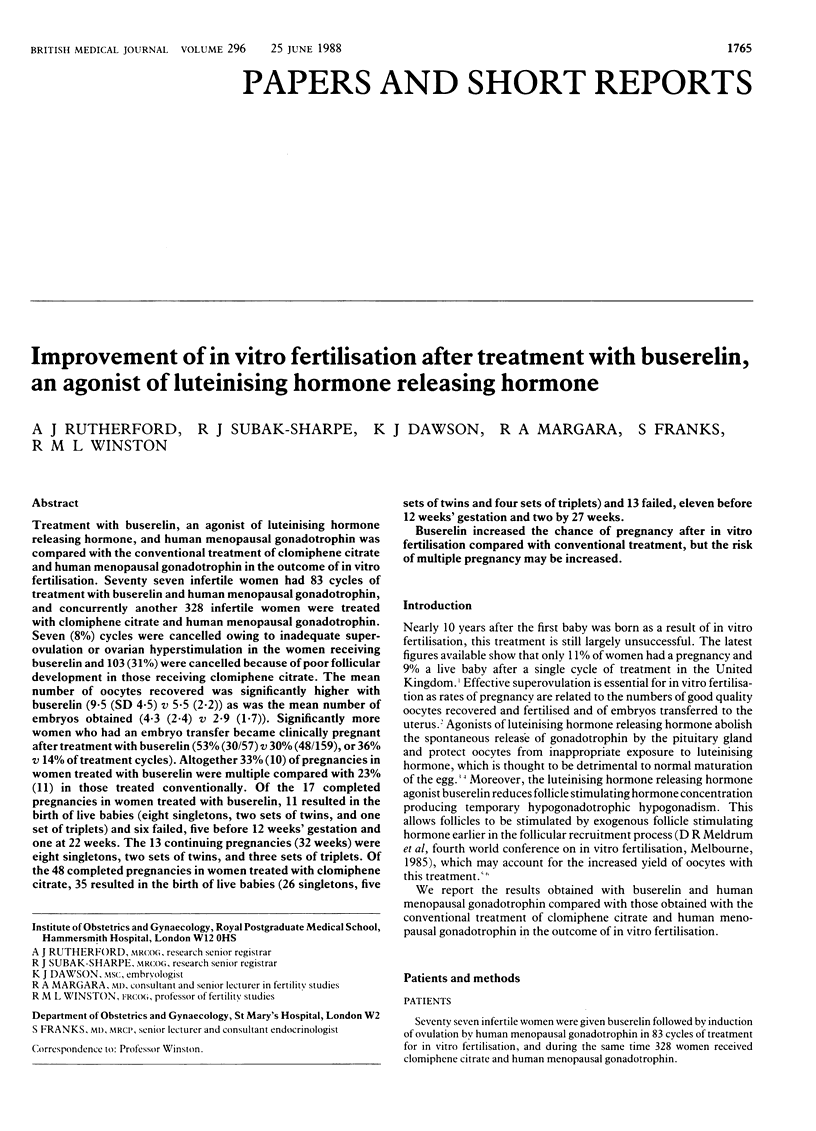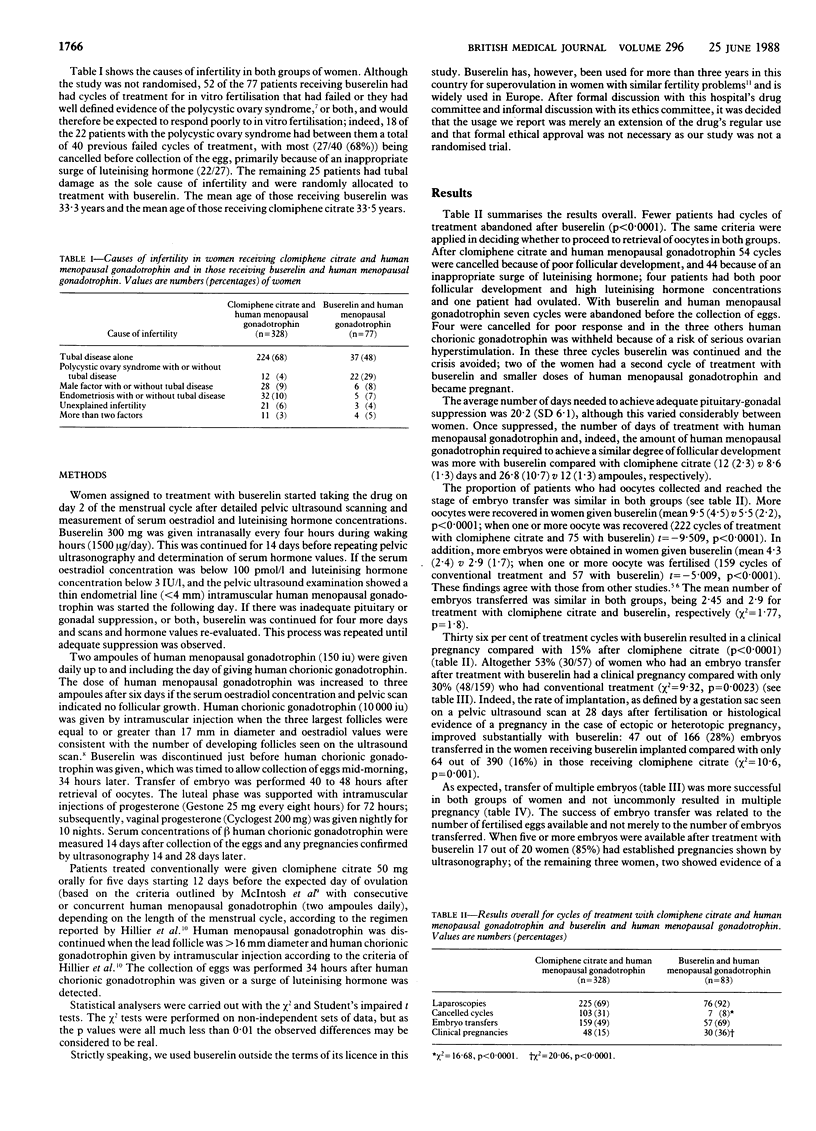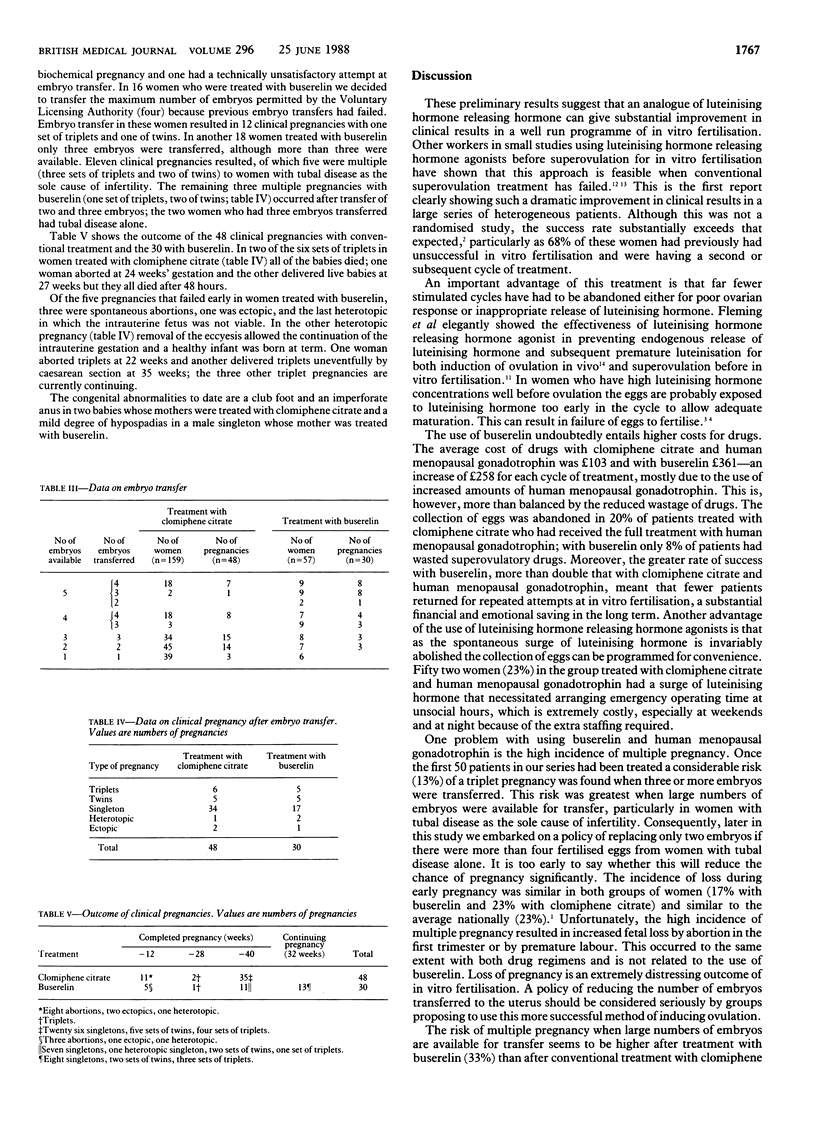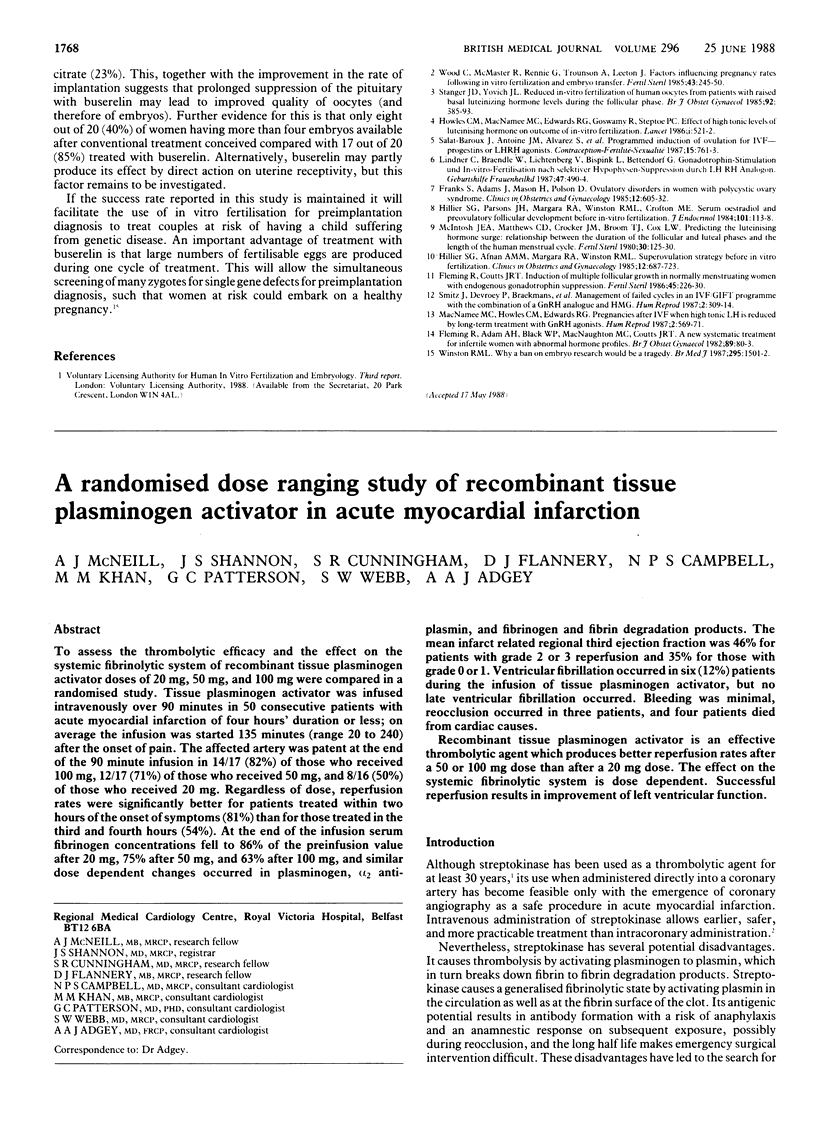Abstract
Treatment with buserelin, an agonist of luteinising hormone releasing hormone, and human menopausal gonadotrophin was compared with the conventional treatment of clomiphene citrate and human menopausal gonadotrophin in the outcome of in vitro fertilisation. Seventy seven infertile women had 83 cycles of treatment with buserelin and human menopausal gonadotrophin, and concurrently another 328 infertile women were treated with clomiphene citrate and human menopausal gonadotrophin. Seven (8%) cycles were cancelled owing to inadequate superovulation or ovarian hyperstimulation in the women receiving buserelin and 103 (31%) were cancelled because of poor follicular development in those receiving clomiphene citrate. The mean number of oocytes recovered was significantly higher with buserelin (9·5 (SD 4·5) v 5·5 (2·2)) as was the mean number of embryos obtained (4·3 (2·4) v 2·9 (1·7)). Significantly more women who had an embryo transfer became clinically pregnant after treatment with buserelin (53% (30/57) v 30% (48/159), or 36% v 14% of treatment cycles). Altogether 33% (10) of pregnancies in women treated with buserelin were multiple compared with 23% (11) in those treated conventionally. Of the 17 completed pregnancies in women treated with buserelin, 11 resulted in the birth of live babies (eight singletons, two sets of twins, and one set of triplets) and six failed, five before 12 weeks' gestation and one at 22 weeks. The 13 continuing pregnancies (32 weeks) were eight singletons, two sets of twins, and three sets of triplets. Of the 48 completed pregnancies in women treated with clomiphene citrate, 35 resulted in the birth of live babies (26 singletons, five sets of twins and four sets of triplets) and 13 failed, eleven before 12 weeks' gestation and two by 27 weeks.
Buserelin increased the chance of pregnancy after in vitro fertilisation compared with conventional treatment, but the risk of multiple pregnancy may be increased.
Full text
PDF



Selected References
These references are in PubMed. This may not be the complete list of references from this article.
- Fleming R., Coutts J. R. Induction of multiple follicular growth in normally menstruating women with endogenous gonadotropin suppression. Fertil Steril. 1986 Feb;45(2):226–230. doi: 10.1016/s0015-0282(16)49159-4. [DOI] [PubMed] [Google Scholar]
- Franks S., Adams J., Mason H., Polson D. Ovulatory disorders in women with polycystic ovary syndrome. Clin Obstet Gynaecol. 1985 Sep;12(3):605–632. [PubMed] [Google Scholar]
- Hillier S. G., Afnan A. M., Margara R. A., Winston R. M. Superovulation strategy before in vitro fertilization. Clin Obstet Gynaecol. 1985 Sep;12(3):687–723. [PubMed] [Google Scholar]
- Howles C. M., Macnamee M. C., Edwards R. G., Goswamy R., Steptoe P. C. Effect of high tonic levels of luteinising hormone on outcome of in-vitro fertilisation. Lancet. 1986 Aug 30;2(8505):521–522. doi: 10.1016/s0140-6736(86)90395-8. [DOI] [PubMed] [Google Scholar]
- Lindner C., Braendle W., Bispink L., Lichtenberg V., Bettendorf G. Gonadotropin-Stimulation und In-vitro-Fertilisation nach selektiver Hypophysen-Suppression durch LH/RH-Analogon. Geburtshilfe Frauenheilkd. 1987 Jul;47(7):490–494. doi: 10.1055/s-2008-1035859. [DOI] [PubMed] [Google Scholar]
- Macnamee M. C., Howles C. M., Edwards R. G. Pregnancies after IVF when high tonic LH is reduced by long-term treatment with GnRH agonists. Hum Reprod. 1987 Oct;2(7):569–571. doi: 10.1093/oxfordjournals.humrep.a136590. [DOI] [PubMed] [Google Scholar]
- McIntosh J. E., Matthews C. D., Crocker J. M., Broom T. J., Cox L. W. Predicting the luteinizing hormone surge: relationship between the duration of the follicular and luteal phases and the length of the human menstrual cycle. Fertil Steril. 1980 Aug;34(2):125–130. doi: 10.1016/s0015-0282(16)44894-6. [DOI] [PubMed] [Google Scholar]
- Smitz J., Devroey P., Braeckmans P., Camus M., Khan I., Staessen C., Van Waesberghe L., Wisanto A., Van Steirteghem A. C. Management of failed cycles in an IVF/GIFT programme with the combination of a GnRH analogue and HMG. Hum Reprod. 1987 May;2(4):309–314. doi: 10.1093/oxfordjournals.humrep.a136540. [DOI] [PubMed] [Google Scholar]
- Stanger J. D., Yovich J. L. Reduced in-vitro fertilization of human oocytes from patients with raised basal luteinizing hormone levels during the follicular phase. Br J Obstet Gynaecol. 1985 Apr;92(4):385–393. doi: 10.1111/j.1471-0528.1985.tb01113.x. [DOI] [PubMed] [Google Scholar]
- Winston R. M. Why a ban on embryo research would be a tragedy. Br Med J (Clin Res Ed) 1987 Dec 12;295(6612):1501–1502. doi: 10.1136/bmj.295.6612.1501. [DOI] [PMC free article] [PubMed] [Google Scholar]
- Wood C., McMaster R., Rennie G., Trounson A., Leeton J. Factors influencing pregnancy rates following in vitro fertilization and embryo transfer. Fertil Steril. 1985 Feb;43(2):245–250. doi: 10.1016/s0015-0282(16)48380-9. [DOI] [PubMed] [Google Scholar]


